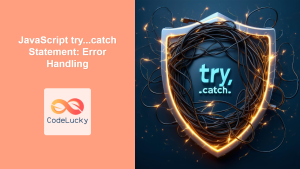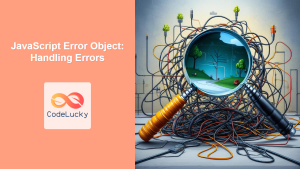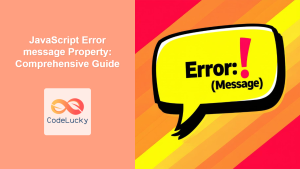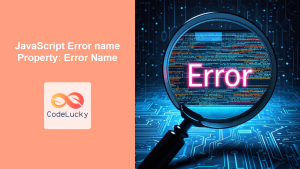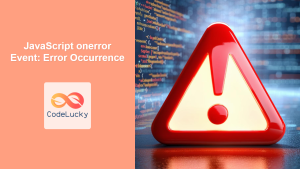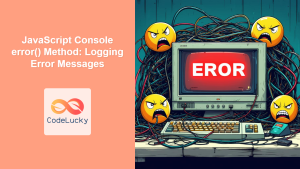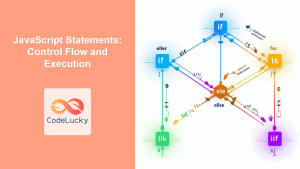JavaScript, like any programming language, is prone to errors. Whether it's a syntax error, a runtime error, or a logical error, understanding how to handle and throw exceptions is crucial for writing robust and reliable code. In this comprehensive guide, we'll dive deep into the world of JavaScript errors, exploring various techniques to handle exceptions and even create custom errors when needed.
Understanding JavaScript Errors
Before we delve into handling and throwing exceptions, it's essential to understand the different types of errors in JavaScript.
Types of Errors
-
Syntax Errors 🔍: These occur when the JavaScript engine encounters code that doesn't follow the language's syntax rules.
-
Runtime Errors ⚡: These happen during the execution of the code, often due to invalid operations.
-
Logical Errors 🧠: These are the trickiest, as the code runs without throwing an error, but doesn't produce the expected result.
Let's look at examples of each:
// Syntax Error
console.log("Hello, World!"; // Missing closing parenthesis
// Runtime Error
let x = 10;
console.log(x.toUpperCase()); // Cannot call toUpperCase() on a number
// Logical Error
function addNumbers(a, b) {
return a - b; // Subtraction instead of addition
}
console.log(addNumbers(5, 3)); // Outputs 2 instead of 8
Handling Exceptions with Try…Catch
The primary mechanism for handling exceptions in JavaScript is the try...catch statement. This allows you to "try" a block of code and "catch" any errors that occur.
Basic Try…Catch Structure
try {
// Code that might throw an error
} catch (error) {
// Code to handle the error
}
Let's see this in action with a practical example:
function divideNumbers(a, b) {
try {
if (b === 0) {
throw new Error("Division by zero is not allowed");
}
return a / b;
} catch (error) {
console.error("An error occurred:", error.message);
return null;
}
}
console.log(divideNumbers(10, 2)); // Outputs: 5
console.log(divideNumbers(10, 0)); // Outputs: An error occurred: Division by zero is not allowed
// null
In this example, we're using try...catch to handle a potential division by zero error. If b is zero, we throw a custom error, which is then caught and handled in the catch block.
The Finally Clause
Sometimes, you want code to run regardless of whether an error occurred. This is where the finally clause comes in handy:
function readFile(filename) {
let file = null;
try {
file = openFile(filename);
// Process file contents
return file.contents;
} catch (error) {
console.error("Error reading file:", error.message);
return null;
} finally {
if (file) {
file.close();
}
}
}
In this example, we ensure that the file is always closed, whether the read operation was successful or not. This is crucial for resource management.
Throwing Custom Exceptions
While JavaScript has built-in error types, sometimes you need to create custom errors to better represent specific issues in your application.
Creating a Custom Error
To create a custom error, you can extend the built-in Error class:
class ValidationError extends Error {
constructor(message) {
super(message);
this.name = "ValidationError";
}
}
function validateUser(user) {
if (!user.name) {
throw new ValidationError("User name is required");
}
if (!user.email) {
throw new ValidationError("User email is required");
}
// More validations...
}
try {
validateUser({ name: "John Doe" });
} catch (error) {
if (error instanceof ValidationError) {
console.error("Validation failed:", error.message);
} else {
console.error("An unexpected error occurred:", error.message);
}
}
This custom ValidationError allows us to distinguish between validation-related errors and other types of errors, enabling more specific error handling.
Advanced Error Handling Techniques
As your applications grow in complexity, you might need more sophisticated error handling strategies. Let's explore some advanced techniques.
Async Error Handling
When working with asynchronous code, error handling becomes a bit trickier. Here's how you can handle errors in async functions:
async function fetchUserData(userId) {
try {
const response = await fetch(`https://api.example.com/users/${userId}`);
if (!response.ok) {
throw new Error(`HTTP error! status: ${response.status}`);
}
const data = await response.json();
return data;
} catch (error) {
console.error("Failed to fetch user data:", error.message);
throw error; // Re-throw the error for the caller to handle
}
}
// Using the async function
fetchUserData(123)
.then(data => console.log("User data:", data))
.catch(error => console.error("Error in main:", error.message));
In this example, we're using try...catch within an async function to handle potential errors during the fetch operation. We're also re-throwing the error to allow the caller to handle it as well.
Error Boundaries
In larger applications, especially those built with frameworks like React, you might want to implement error boundaries. While not a native JavaScript feature, the concept is worth understanding:
class ErrorBoundary extends React.Component {
constructor(props) {
super(props);
this.state = { hasError: false };
}
static getDerivedStateFromError(error) {
return { hasError: true };
}
componentDidCatch(error, errorInfo) {
logErrorToService(error, errorInfo);
}
render() {
if (this.state.hasError) {
return <h1>Something went wrong.</h1>;
}
return this.props.children;
}
}
// Usage
<ErrorBoundary>
<MyComponent />
</ErrorBoundary>
Error boundaries catch errors in their child components, log those errors, and display a fallback UI instead of the component tree that crashed.
Best Practices for Error Handling
To wrap up, let's discuss some best practices for error handling in JavaScript:
-
Be Specific 🎯: Catch specific errors when possible, rather than using a catch-all approach.
try { // Some code that might throw different types of errors } catch (error) { if (error instanceof TypeError) { // Handle TypeError } else if (error instanceof RangeError) { // Handle RangeError } else { // Handle other errors } } -
Avoid Empty Catch Blocks ❌: Always do something meaningful in your catch blocks, even if it's just logging the error.
-
Use Finally for Cleanup 🧹: Use the
finallyblock for cleanup operations that should occur whether an error was thrown or not. -
Don't Overuse Try…Catch ⚖️: While important, wrapping every piece of code in try…catch can make your code harder to read. Use it judiciously.
-
Provide Meaningful Error Messages 💬: When throwing custom errors, make sure the error messages are clear and informative.
-
Log Errors 📝: Always log errors for debugging purposes, but be careful not to log sensitive information.
-
Consider the User Experience 👤: When displaying errors to users, provide helpful information without exposing system details.
Conclusion
Error handling is a crucial aspect of writing robust JavaScript code. By understanding how to effectively use try…catch, throw custom exceptions, and implement advanced error handling techniques, you can create more reliable and maintainable applications. Remember, good error handling not only prevents your application from crashing but also provides valuable feedback to both developers and users when things go wrong.
As you continue to develop your JavaScript skills, make error handling an integral part of your coding practice. It's not just about fixing errors; it's about anticipating them and handling them gracefully. Happy coding, and may your errors always be caught and handled with care! 🚀🔧




